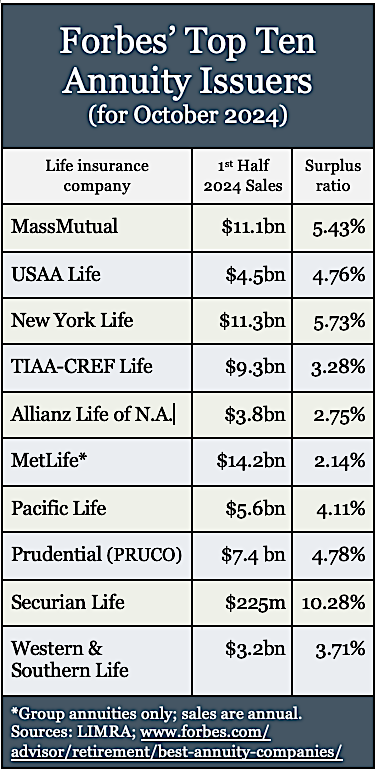
Investment advisers instinctively optimize each client’s portfolio performance, or try to. For clients in the “accumulation stage,” when the goal is almost always to pursue the highest investment gain (at the client’s self-selected risk-tolerance level), that makes perfect sense.
But when clients are retiring, they may have priorities other than performance. And if the adviser’s compensation isn’t tied to the client’s account balance or to the cost of a product, advisers may have no reason not to follow the client’s lead.
Adviser Andy Panko of Edison, NJ, describes a recent case involving a newly-retired client with an unusual request. The 62-year-old Oregon woman (Panko works with investors nationwide) wanted to buy a guaranteed lifetime income stream of $600 per month at the lowest price.
After a 40-year corporate career, the woman had saved about $1 million. Her investments were diversified across brokerage accounts, a 401(k) and a Roth IRA. Healthy, unmarried and without children, she shared living expenses with a partner of 30 years in a mortgage-free house that he owned.
At 62, she expected to receive an inflation-adjusted monthly payment of $2,400 from Social Security. Based on her projected essential monthly expenses of just $3,000, she had decided to top-up her Social Security benefit with $600 more in guaranteed monthly income. Otherwise she’d rely on Panko to monitor her investments, periodically rebalance her portfolio and minimize her annual tax burden.
That strategy wouldn’t have been Panko’s own choice. He suggested, in vain, that she postpone claiming Social Security for at least a few years to capture the 8% annual delay-bonus. As for annuities, Panko, who is 46, isn’t insurance-licensed.
“I give my opinions, but ultimately it’s their call,” Panko told me during a phone interview last week. “This client wanted the look and feel of a paycheck. That’s also why she started Social Security a month after she retired.”
As for legacy concerns, the woman had only her partner (two years her senior) to consider. She preferred an income-generating product that would refund any unpaid balance to him if she died early. That pointed to either a single-premium immediate annuity (SPIA) with a cash refund or a deferred annuity with a guaranteed lifetime withdrawal benefit, or GLWB.
Search for lowest price
Panko’s mission, which he accepted, was to find the cheapest $600/month lifetime income for a 62-year-old female. Taking to the Internet for research, he touched-base at immediateannuities.com, blueprintincome.com, RetireOne. (These happened to be three of the annuity sales platforms that I recommend in Annuities for Dummies (Wiley, 2023). He also visited “Low-Load Insurance Solutions” (llis.com), one of the annuity platforms that writes contracts for clients of Registered Investment Advisors.
First, Panko compared prices for a $600/month cash-refund SPIA. A New York Life contract cost $111,941. An Integrity Life contract for $111,460. As a member of the Financial Planning Association, he put a query on one of its online forums. An insurance agent called him, and alerted him to a Nationwide contract for $107,211.
But the client’s eventual solution was not a SPIA but a fixed indexed annuity (FIA). A second person who responded to the FPA query suggested that Panko and his client consider a fixed indexed annuity with a GLWB. This insider knew, as Panko would not have, that FIA issuers have worked hard to increase the payouts on their living benefit riders. FIA/GLWB payouts surpassed those of variable annuity GLWBs several years ago. After interest rates rose in 2022, some new FIA/GLWB contracts were built to out-pay SPIAs.
Panko’s attention was directed to an FIA/GLWB contract (NAC BenefitsSolutions 10) issued by North American Life (an A+ sister company to Midland National, under the Sammons Financial Group umbrella) that could render a lifelong $600-a-month income, starting immediately, for exactly $102,309. The Oregon woman “became the first of my clients to buy an FIA,” Panko told RIJ in a phone interview.
Although the contract, like all FIAs, uses derivatives to capture part of the potential increase in one or more market indices (in this case, the S&P MARC 5% Excess Return Index) Panko’s client wasn’t in it for growth. And while the 1.20% rider fee might accelerate the shrinkage of the underlying account value (i.e., the cash refund), she was satisfied with minimum balance that the contract maintained until vanishing in the 13th contract year.
How can North American afford to offer to beat the competition by up to $9,000? The lower premium is supported by the rider fee, which the issuer can raise to as much as 3% after the tenth anniversary of the contract. There’s also 25% premium bonus in the first year. These factors help raise the usual 5.63% payout rate for 62-year-old contract owners to about 7.2%⏤thus producing a $600/month ($7,200/year) payout for $102,309.
Industry insiders add that the payout rates of FIA/GLWBs in general may be propped up by the fact that owners of these contracts surrender (cancel or “lapse”) them at relatively high rates. In the design of an FIA, there’s a trade-off between the crediting rates and the payout rates; FIAs with GLWBs underperform FIAs without them.
Anecdotally, many near-retirees buy FIA/GLWBs expecting high index returns and high payout rates. When the actual index returns disappoint them, they lapse the contracts. “Just enough people don’t turn the riders on” to create a pricing advantage for those who do, said Angie Welsh, managing director at Stan Haithcock’s stantheannuityman.com platform, where income-generating annuities are typically recommended.
But the complexity of the FIA contract didn’t bother the client as long as the price was right. She was determined not to lapse the contract, which would mean incurring a surrender charge or forfeiting rider fees. It didn’t bother her that her income payment wouldn’t rise with inflation. (Annual fees and withdrawals would neutralize any positive credits.) She didn’t foresee dipping into the contract for more than $600 per month—an indulgence that would lower her monthly payment.
Another path was open to the client. Panko was well aware of it. Leveraging the robust interest rates available at the time (2023), she could have put $140,000 into a ten-year MYGA (multi-year guaranteed annuity) with a 5% payout. It would have cranked out the desired level of income with similar safety—and refunded her principal after 10 years.
But that would introduce a level of interest rate risk that the client was keen to avoid. “When the MYGA matures, you’re at the mercy of rates at the time,” Panko said. “That’s why she originally wanted a SPIA. The MYGA would be a relatively short-term solution.”
Flat-fee revenue model
Panko was agnostic about his client’s choice of product—to a degree that’s fairly unusual for an investment adviser. His revenue model gives him that luxury. Rather than earn a percentage of the assets he manages, or accept third-party commissions, or charge an hourly rate, he charges a flat fee. The current annual fee for new married clients is $12,000 and for single people $10,800.
“It takes AUM out of the equation,” he told RIJ. Unlike an investment adviser representative at an RIA, who might arrange the purchase of a no-commission deferred annuity at a platform like DPLFinancial.com or llis.com, he has no reason to include the annuity premium in his AUM, even if it comes out of his AUM.
To reach the $12,000 number (a rate that has risen gradually over the five years that he’s been independent) and to make sure that it would be competitive, Panko benchmarked against the fees that high-net-worth clients would typically pay an adviser at a big brokerage for the ongoing investment and tax services that he provides.
All of Panko’s clients are in the high-net-worth category. “Because I have a flat-fee, most of my clients have a few million dollars,” he said. “The average AUM would be about $2.5 million.” His clients rarely need more guaranteed income than Social Security provides, and 4% a year is usually the most that they’ll need to draw down from savings.
A native of New Jersey, Panko has an undergraduate degree from the University of Delaware, an MBA from Rutgers, and designations as a Certified Financial Planner and a Retirement Income Certified Professional (from the American College of Financial Services).
Panko worked for several large institutions, including Prudential and Bank of America/Merrill Lynch before setting up his own advisory practice. He now manages some $200 million for about 80 clients. “I cater to each particular client’s preferences,” he told RIJ. “Different solutions help different clients. But the ultimate goal for most clients is just to sleep well at night.”
© 2024 RIJ Publishing LLC. All rights reserved.


